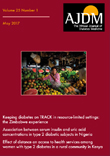Understanding Insulin: The Lifeline for Diabetes Management
*Corresponding Author:
Received: 01-Apr-2024, Manuscript No. ajdm-24-129820; Editor assigned: 03-Apr-2024, Pre QC No. ajdm-24-129820(PQ); Reviewed: 17-Apr-2024, QC No. ajdm-24-129820; Revised: 22-Apr-2024, Manuscript No. ajdm-24-129820(R); Published: 29-Apr-2024, DOI: 10.54931/AJDM-32.2.12.
Introduction
Diabetes, a chronic condition affecting millions worldwide, revolves around the intricate dance of insulin within the body. Insulin, often termed the “key” to glucose regulation, plays a pivotal role in diabetes management and understanding its mechanisms is crucial for those living with the condition. Insulin, a hormone produced by the pancreas, acts as a messenger facilitating the uptake of glucose from the bloodstream into cells, where it is utilized for energy production.
Description
In individuals without diabetes, insulin secretion is finely tuned, responding to fluctuations in blood glucose levels to maintain equilibrium. However, in diabetes, this delicate balance is disrupted. There are primarily two types of diabetes: Type 1 and Type 2. Type 1 diabetes results from the body’s immune system attacking and destroying the insulin-producing beta cells in the pancreas. Consequently, individuals with Type 1 diabetes produce little to no insulin, necessitating external insulin administration for survival. Type 2 diabetes, on the other hand, typically develops due to insulin resistance, where cells become less responsive to insulin’s effects. Initially, the pancreas compensates by producing more insulin, but over time, it may fail to keep up with the demand, leading to elevated blood glucose levels. For individuals with Type 1 diabetes and some with Type 2, insulin therapy is a mainstay of treatment. Various forms of insulin are available, categorized based on their onset, peak, and duration of action. Rapid-acting insulin mimics the body’s natural insulin response to meals, while longacting insulin provides a steady baseline level throughout the day. Insulin can be administered via injections or insulin pumps. Injection sites vary, with common locations being the abdomen, thighs, or buttocks. Insulin pumps, small devices worn externally, deliver insulin continuously, offering flexibility in dosing and mealtime insulin adjustments. Maintaining optimal blood glucose levels is paramount in diabetes management to prevent both shortterm complications like hypoglycemia and hyperglycemia and long-term complications such as cardiovascular disease, nerve damage, and kidney failure. Insulin serves as the cornerstone in achieving glycemic control by regulating blood glucose levels effectively. Despite its critical role, insulin therapy poses challenges. The need for frequent blood glucose monitoring, insulin dose adjustments, and the risk of hypoglycemia can be burdensome for individuals with diabetes. Moreover, insulin access and affordability remain significant concerns globally, particularly in low-income countries. However, ongoing research and technological advancements offer promising solutions. Continuous glucose monitoring (CGM) systems provide real-time glucose readings, aiding in personalized insulin dosing and reducing the risk of hypoglycemia. Additionally, the development of faster-acting insulins and alternative delivery methods, such as inhalable insulin, aims to enhance convenience and efficacy. Insulin stands as a beacon of hope for individuals navigating the complex terrain of diabetes. Its intricate interplay with glucose regulation underscores its significance in diabetes management. While challenges persist, advancements in research and technology continue to redefine diabetes care, empowering individuals to lead fulfilling lives despite the diagnosis.1-4
Conclusion
As we unravel the mysteries of insulin further, we move closer to a future where diabetes becomes not a barrier, but a manageable aspect of life. Various forms of insulin are available, categorized based on their onset, peak, and duration of action. Rapid-acting insulin mimics the body’s natural insulin response to meals, while long-acting insulin provides a steady baseline level throughout the day. Insulin can be administered via injections or insulin pumps. Injection sites vary, with common locations being the abdomen, thighs, or buttocks. Insulin pumps, small devices worn externally, deliver insulin continuously, offering flexibility in dosing and mealtime insulin adjustments.
Acknowledgement
None.
Conflict Of Interest
The author has nothing to disclose and also state no conflict of interest in the submission of this manuscript.
References
- Rossi PG, Marino M, Formisano D, Venturelli F. Characteristics and outcomes of a cohort of COVID-19 patients in the province of Reggio Emilia, Italy. PLOS One; 2020:15(8):e0238281.
- Richardson S, Hirsch JS, Narasimhan M. Presenting characteristics, comorbidities, and outcomes among 5700 patients hospitalized with COVID-19 in the New York City area. JAMA; 2020:323(20):2052-2059.
- Arentz M, Yim E, Klaff L. Characteristics and outcomes of 21 critically ill patients with COVID-19 in Washington State. JAMA; 2020:323(16):1612-1614.
- Cariou B, Hadjadj S, Wargny M. Phenotypic characteristics and prognosis of inpatients with COVID-19 and diabetes: The CORONADO study. Diabetologia; 2020:63:1500-1515.





